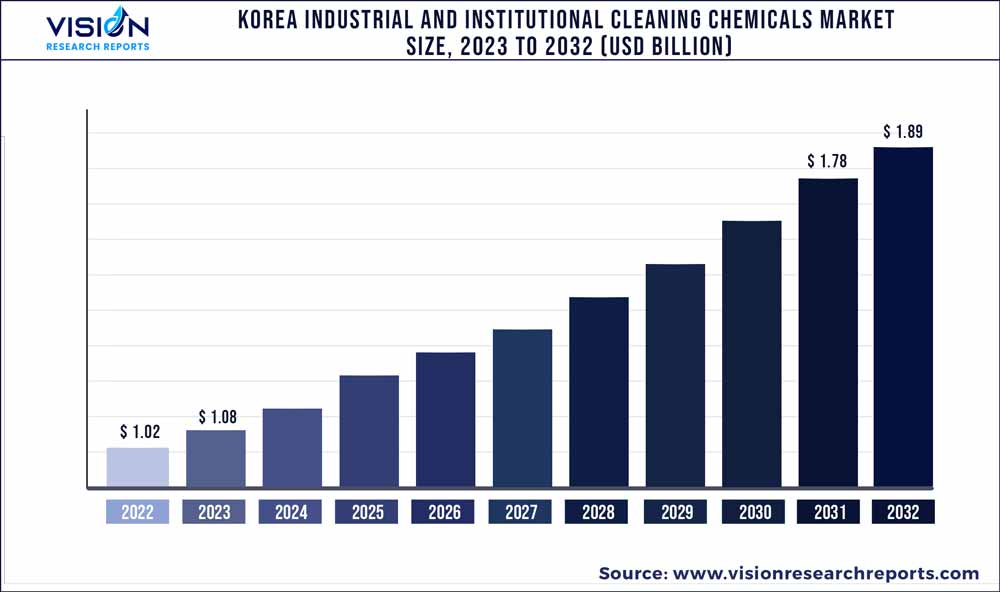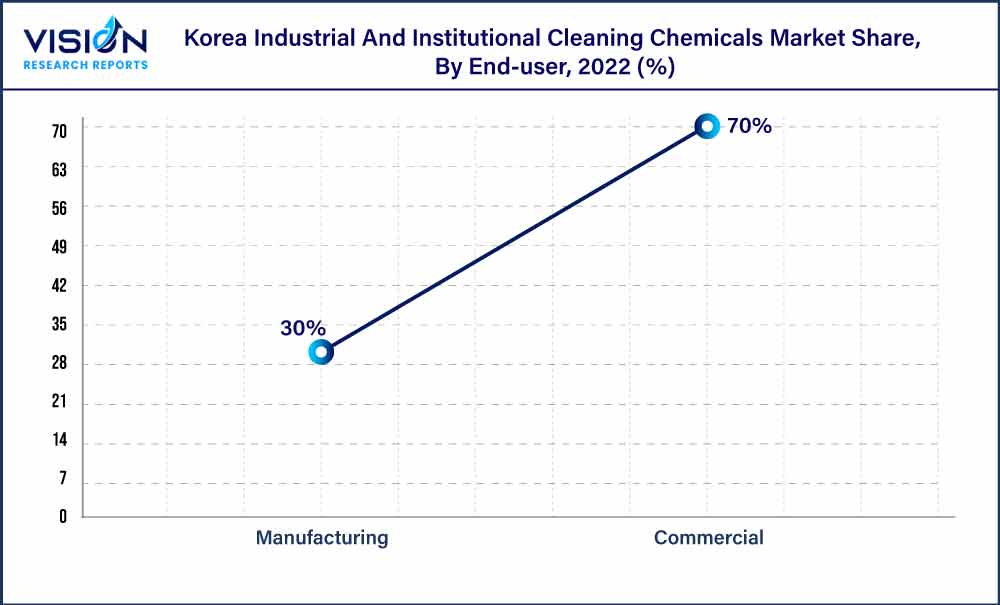The Korea industrial and institutional cleaning chemicals market size was estimated at around USD 1.02 billion in 2022 and it is projected to hit around USD 1.89 billion by 2032, growing at a CAGR of 6.37% from 2023 to 2032.

Key Pointers
Report Scope of the Korea Industrial And Institutional Cleaning Chemicals Market
| Report Coverage | Details |
| Market Size in 2022 | USD 1.02 billion |
| Revenue Forecast by 2032 | USD 1.89 billion |
| Growth rate from 2023 to 2032 | CAGR of 6.37% |
| Base Year | 2022 |
| Forecast Period | 2023 to 2032 |
| Market Analysis (Terms Used) | Value (US$ Million/Billion) or (Volume/Units) |
| Companies Covered | 3M; BASF SE; Procter & Gamble; The Clorox Company; Reckitt Benckiser Group Plc; Croda International Plc; Eastman Chemical Corporation; Huntsman International LLC; Solvay; Dow; Sasol; DDC Dolphin Ltd.; Kook Je Industry; Fireball; Luminus KOREA; ISU Chemical |
The growth is attributed to the rising demand for cleaning products such as cleaners, sanitizers, and disinfectants in the commercial as well as manufacturing sectors in Korea. Rapid urbanization and growing consumer awareness regarding preventive healthcare have enabled consumers to spend more on general-purpose cleaning products. Furthermore, increasing literacy rates and rising awareness among consumers regarding workplace hygiene have augmented the penetration of institutional cleaning chemicals. Additionally, the high prevalence of diseases in the Asia Pacific region is another factor driving the market growth.
According to the Korean National Healthcare-associated Infections Surveillance System, the region has a prevalence of various types of infections such as urinary catheter-associated infections, central line-associated infections, and ventilator-associated infections with urinary catheter-associated accounting for the highest number of cases. This has led to the increased adoption of cleaning products in healthcare settings. Thus, the rising hygiene standards in the healthcare sector are expected to have a positive impact on the demand for the product market in the region over the forecast period.
South Korea emerged as the largest consumer of the product in Korea. This is attributed to the advancing demand for the product in the commercial and manufacturing sectors in the country. Moreover, the outbreak of diseases or pandemics, such as COVID-19, has significantly impacted the demand for cleaning chemicals. In response to health concerns, businesses and institutions have increased their cleaning and disinfection protocols, resulting in higher demand for cleaning products.
Raw Material Insights
Surfactants in the raw material segment dominated the market with a revenue share of 29% in 2022. This growth is attributed to the fact that they are highly effective at removing dirt and other substances from surfaces. Surfactants work by reducing the surface tension between two substances, allowing them to mix more easily. This makes it easier for cleaning solutions to penetrate and remove dirt, oil, and other substances from the surface being cleaned.
Non-ionic surfactants among other surfactants emerged as the major raw material in the manufacturing of the product. This is attributed to the fact that they are typically gentle on surfaces and can be used on a wide variety of materials, making them a popular choice for cleaning products used in industrial and institutional settings. On the other hand, anionic surfactants are often more effective at removing dirt and stains from surfaces, making them a common ingredient in laundry detergents and carpet cleaners.
Biocides is another segment anticipated to witness growth over the forecast period. High-performance biocides are preferred for hard surface cleaning as well as in a range of deep-cleaning applications across the industrial sector. Biocides including non-oxidizing and oxidizing deliver superior performance in water system controls and therefore, are largely used in water treatment applications to control microbial activities. Furthermore, with the advancement in technology and constant innovations by key chemical manufacturers, biocide-treated surfaces are now commonly found, which comprise active ingredients such as metallic ions and triclosan.
Product Insights
General purpose cleaners in the product segment dominated the Korea industrial & institutional cleaning chemicals market with a revenue share of 35% in 2022. This is attributed to the growing awareness about the importance of cleanliness and hygiene, increasing utilization of these chemicals across various industries, and the availability of a wide range of cleaning products. General purpose cleaners, also known as all-purpose cleaners, comprise a combination of solvents, surfactants, and chelants or either of these ingredients. They are broadly utilized to remove soil and greasy stains from hard floor surfaces. The presence of disinfectants in these cleaning products provides the ability to ensure surface disinfection by reducing microbial activity on surfaces and killing bacteria and viruses.
Laundry care products is another segment anticipated to witness significant growth over the forecast period. The demand for fabric care products and laundry care chemicals has been increasing significantly in Korea in the past decades. Multinationals in Korea, such as Croda International, Henkel AG, and BASF SE, are expanding their product portfolios for essential laundry care detergents, disinfectants, baking soda products, oxygen bleach, and distilled white vinegar, which are the essential ingredients in the laundry detergent industry. With consumer awareness regarding valuing their apparel purchases and maintenance, the demand for laundry detergents and detergent additives has increased extensively.
The majority of the brands are focusing on developing premium high-performance products for applications in front load or top load washers to capture domestic as well as commercial market space across the country. Increasing innovations in terms of product development coupled with the constant demand for various laundry care products from customers are anticipated to reflect steady demand for the product over the forecast period.
End-use Insights
The commercial segment dominated the market with a revenue share of 70% in 2022. This is attributed to the fact that the application of the product in the commercial sector largely comprises foodservice, healthcare, laundry care, retail, various institutional buildings, and more. The demand for various cleaning chemicals is persistent across these industries. Departmental stores, high retail stores, and various public institutions such as schools, colleges, recreational spaces, courts, and more demand all-purpose cleaners as well as a variety of disinfectants and sanitizing products. Furthermore, the healthcare sector highly demands sanitizers for various equipment and bulk quantities of disinfectant products to ensure all-around hygiene.

Healthcare in the commercial end-use segment dominated the market with a revenue share of 35% in 2022. This is attributed to the importance of maintaining a sterile environment to prevent the spread of diseases and infections in the healthcare industry. The use of cleaning chemicals is vital to prevent the spread of infections among patients, visitors, and healthcare workers. Hospitals, nursing homes, and other healthcare environments require frequent cleaning to minimize the risk of infection, and the use of industrial & institutional cleaning chemicals is essential to maintaining safety and reducing the risk of cross-contamination.
The manufacturing end-use segment is also anticipated to witness significant growth over the forecast period. This is attributed to the growing usage of the product in the food & beverage processing industry. These cleaning chemicals are specifically formulated to clean and sanitize the surfaces and equipment used during food and beverage manufacturing processes. Moreover, food and beverage processing plants require strict hygiene standards to prevent the contamination of products, which could lead to health problems for consumers. Cross-contamination and the spread of harmful bacteria and viruses are possible within the processing plant. Therefore, high-quality products are critical in ensuring that these facilities maintain optimal hygiene standards.
Korea Industrial And Institutional Cleaning Chemicals Market Segmentations:
By Raw Material
By Product
By End-use
Chapter 1. Introduction
1.1. Research Objective
1.2. Scope of the Study
1.3. Definition
Chapter 2. Research Methodology
2.1. Research Approach
2.2. Data Sources
2.3. Assumptions & Limitations
Chapter 3. Executive Summary
3.1. Market Snapshot
Chapter 4. Market Variables and Scope
4.1. Introduction
4.2. Market Classification and Scope
4.3. Industry Value Chain Analysis
4.3.1. Raw Material Procurement Analysis
4.3.2. Sales and Distribution Raw Material Analysis
4.3.3. Downstream Buyer Analysis
Chapter 5. COVID 19 Impact on Korea Industrial And Institutional Cleaning Chemicals Market
5.1. COVID-19 Landscape: Korea Industrial And Institutional Cleaning Chemicals Industry Impact
5.2. COVID 19 - Impact Assessment for the Industry
5.3. COVID 19 Impact: Major Government Policy
5.4. Market Trends and Opportunities in the COVID-19 Landscape
Chapter 6. Market Dynamics Analysis and Trends
6.1. Market Dynamics
6.1.1. Market Drivers
6.1.2. Market Restraints
6.1.3. Market Opportunities
6.2. Porter’s Five Forces Analysis
6.2.1. Bargaining power of suppliers
6.2.2. Bargaining power of buyers
6.2.3. Threat of substitute
6.2.4. Threat of new entrants
6.2.5. Degree of competition
Chapter 7. Competitive Landscape
7.1.1. Company Market Share/Positioning Analysis
7.1.2. Key Strategies Adopted by Players
7.1.3. Vendor Landscape
7.1.3.1. List of Suppliers
7.1.3.2. List of Buyers
Chapter 8. Korea Industrial And Institutional Cleaning Chemicals Market, By Raw Material
8.1. Korea Industrial And Institutional Cleaning Chemicals Market, by Raw Material, 2023-2032
8.1.1 Chlor-Alkali
8.1.1.1. Market Revenue and Forecast (2020-2032)
8.1.2. Surfactants
8.1.2.1. Market Revenue and Forecast (2020-2032)
8.1.3. Solvent
8.1.3.1. Market Revenue and Forecast (2020-2032)
8.1.4. Phosphate
8.1.4.1. Market Revenue and Forecast (2020-2032)
8.1.5. Biocides
8.1.5.1. Market Revenue and Forecast (2020-2032)
8.1.6. Other
8.1.6.1. Market Revenue and Forecast (2020-2032)
Chapter 9. Korea Industrial And Institutional Cleaning Chemicals Market, By Product
9.1. Korea Industrial And Institutional Cleaning Chemicals Market, by Product, 2023-2032
9.1.1. General Purpose Cleaners
9.1.1.1. Market Revenue and Forecast (2020-2032)
9.1.2. Disinfectants & Sanitizers
9.1.2.1. Market Revenue and Forecast (2020-2032)
9.1.3. Laundry Care Products
9.1.3.1. Market Revenue and Forecast (2020-2032)
9.1.4. Vehicle Wash Products
9.1.4.1. Market Revenue and Forecast (2020-2032)
9.1.5. Other Products
9.1.5.1. Market Revenue and Forecast (2020-2032)
Chapter 10. Korea Industrial And Institutional Cleaning Chemicals Market, By End-use
10.1. Korea Industrial And Institutional Cleaning Chemicals Market, by End-use, 2023-2032
10.1.1. Commercial
10.1.1.1. Market Revenue and Forecast (2020-2032)
10.1.2. Manufacturing
10.1.2.1. Market Revenue and Forecast (2020-2032)
Chapter 11. Korea Industrial And Institutional Cleaning Chemicals Market, Regional Estimates and Trend Forecast
11.1. Korea
11.1.1. Market Revenue and Forecast, by Raw Material (2020-2032)
11.1.2. Market Revenue and Forecast, by Product (2020-2032)
11.1.3. Market Revenue and Forecast, by End-use (2020-2032)
Chapter 12. Company Profiles
12.1. 3M.
12.1.1. Company Overview
12.1.2. Product Offerings
12.1.3. Financial Performance
12.1.4. Recent Initiatives
12.2. BASF SE.
12.2.1. Company Overview
12.2.2. Product Offerings
12.2.3. Financial Performance
12.2.4. Recent Initiatives
12.3. Procter & Gamble.
12.3.1. Company Overview
12.3.2. Product Offerings
12.3.3. Financial Performance
12.3.4. Recent Initiatives
12.4. The Clorox Company.
12.4.1. Company Overview
12.4.2. Product Offerings
12.4.3. Financial Performance
12.4.4. Recent Initiatives
12.5. Reckitt Benckiser Group Plc.
12.5.1. Company Overview
12.5.2. Product Offerings
12.5.3. Financial Performance
12.5.4. Recent Initiatives
12.6. Croda International Plc
12.6.1. Company Overview
12.6.2. Product Offerings
12.6.3. Financial Performance
12.6.4. Recent Initiatives
12.7. Eastman Chemical Corporation.
12.7.1. Company Overview
12.7.2. Product Offerings
12.7.3. Financial Performance
12.7.4. Recent Initiatives
12.8. Huntsman International LLC
12.8.1. Company Overview
12.8.2. Product Offerings
12.8.3. Financial Performance
12.8.4. Recent Initiatives
12.9. Solvay.
12.9.1. Company Overview
12.9.2. Product Offerings
12.9.3. Financial Performance
12.9.4. Recent Initiatives
12.10. Dow
12.10.1. Company Overview
12.10.2. Product Offerings
12.10.3. Financial Performance
12.10.4. Recent Initiatives
Chapter 13. Research Methodology
13.1. Primary Research
13.2. Secondary Research
13.3. Assumptions
Chapter 14. Appendix
14.1. About Us
14.2. Glossary of Terms
 Cross-segment Market Size and Analysis for
Mentioned Segments
Cross-segment Market Size and Analysis for
Mentioned Segments
 Additional Company Profiles (Upto 5 With No Cost)
Additional Company Profiles (Upto 5 With No Cost)
 Additional Countries (Apart From Mentioned Countries)
Additional Countries (Apart From Mentioned Countries)
 Country/Region-specific Report
Country/Region-specific Report
 Go To Market Strategy
Go To Market Strategy
 Region Specific Market Dynamics
Region Specific Market Dynamics Region Level Market Share
Region Level Market Share Import Export Analysis
Import Export Analysis Production Analysis
Production Analysis Others
Others